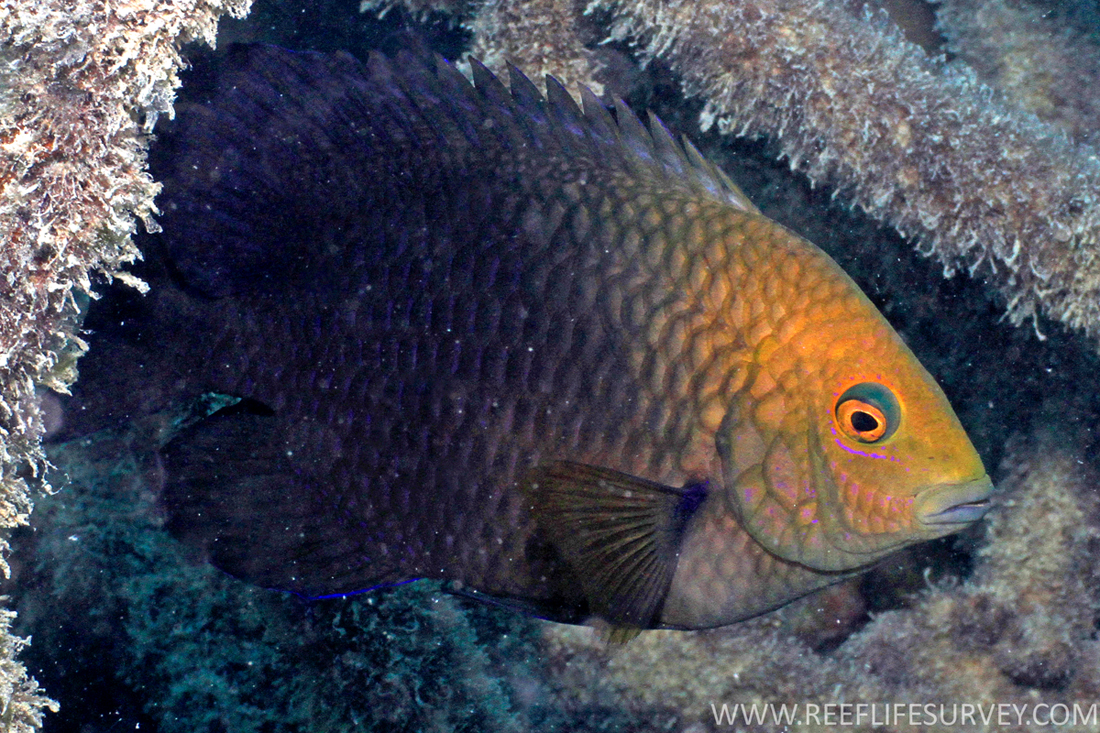- Classification
- ACTINOPTERYGII
- PERCIFORMES
- POMACENTRIDAE
- Hemiglyphidodon
- plagiometopon
Lagoon Damsel, Hemiglyphidodon plagiometopon (Bleeker 1852)
Other Names: Sweetlip Damsel

A Lagoon Damsel, Hemiglyphidodon plagiometopon, on the Great Barrier Reef, Queensland. Source: Graham Edgar / Reef Life Survey. License: CC by Attribution
Summary:
A large brown damselfish, sometimes with a paler orange-brown head gradually becoming darker towards the rear of the body, and pinkish markings on the gill cover. Juveniles are dark blue to brownish anteriorly, yellow posteriorly and on the belly, with a large iridescent blue ocellus on the dorsal fin, and blue bands and spots anteriorly on the body.
Cite this page as:
Dianne J. Bray, Hemiglyphidodon plagiometopon in Fishes of Australia, accessed 27 Jun 2025, https://fishesofaustralia.net.au/Home/species/356
Lagoon Damsel, Hemiglyphidodon plagiometopon (Bleeker 1852)
More Info
|
Distribution |
Recorded in Australia from Rowley Shoals and Scott Reef, WA, Ashmore Reef, Timor Sea, and the northern part of the Great Barrier Reef, QLD. The species occurs elsewhere in the tropical, east-Indo-west Pacific. Inhabits sheltered shallow reefs and lagoons, often in turbid, silty areas - amongst branching corals. |
|
Features |
Dorsal fin XIII, 14-15; Anal fin II, 14-15; Pectoral fin 16-17; Lateral line scales 16-17; Gill rakers (total first arch) 65-85 (2-3 times more than other damselfish species). |
|
Feeding |
Detrivore - although this territorial damsel fish actively defends algal covered territories, studies have shown that the species feeds mostly on fine detrital material. Very small amounts of algae and invertebrates such as polychaetes, crustaceans and foraminiferans are also consumed (Wilson & Bellwood 1997). The species has 2-3 times more gill rakers on the first arch than any other damselfish, which supports the fact that it feeds mostly on fine detritus. |
|
Biology |
Forms pairs while breeding, and females lay demersal eggs that adhere to the substrate. The male parent guards and aerates the eggs until the larvae hatch. |
|
Species Citation |
Glyphisodon plagiometopon Bleeker, 1852, Natuurwetensch. Tijdschr. Nederland. Indië 3: 67. Type locality: Singapore. |
|
Author |
Dianne J. Bray |
Lagoon Damsel, Hemiglyphidodon plagiometopon (Bleeker 1852)
References
Allen, G.R. 1975. Damselfishes of the South Seas. New Jersey : T.F.H. Publications 237 pp. 251 figs.
Allen, G.R. 1991. Damselfishes of the World. Melle, Germany : Mergus Verlag 271 pp.
Allen, G.R. 1997. Marine Fishes of Tropical Australia and South-east Asia. Perth : Western Australian Museum 292 pp. 106 pls.
Allen, G. R. 2001. Family Pomacentridae. pp. in Carpenter, K.E. & Niem, T.H. (eds). The Living Marine Resources of the Western Central Pacific. FAO Species Identification Guide for Fisheries Purposes. Rome : FAO Vol. 6 pp. 3381-4218.
Allen, G.R. & Erdmann, M.V. 2012. Reef fishes of the East Indies. Perth : Tropical Reef Research 3 vols, 1260 pp.
Allen, G.R. & Swainston, R. 1988. The Marine Fishes of North-Western Australia. A field guide for anglers and divers. Perth, WA : Western Australian Museum vi 201 pp., 70 pls.
Bleeker, P. 1852. Bijdrage tot de kennis der ichthyologische fauna van Singapore. Natuurwetenschappelijk Tijdschrift voor Nederlandsch Indië 3: 51-86.
Hutchins, J.B. 2001. Biodiversity of shallow reef fish assemblages in Western Australia using a rapid censusing technique. Records of the Western Australian Museum 20: 247-270.
Kuiter, R.H. 1992. Tropical Reef-Fishes of the Western Pacific, Indonesia and Adjacent Waters. Jakarta : PT Gramedia Pustaka Utama 314 pp. pls.
Lassuy, D.R. 1980. Effects of ‘farming’ behavior by Eupomacentrus lividus and Hemiglyphidodon plagiometopon on algal community structure. Bulletin of Marine Science 30: 304–312.
Randall, J.E., Allen, G.R. & Steene, R. 1990. Fishes of the Great Barrier Reef and Coral Sea. Bathurst : Crawford House Press 507 pp. figs.
Randall, J.E., Allen, G.R. & Steene, R. 1997. Fishes of the Great Barrier Reef and Coral Sea. Bathurst : Crawford House Press 557 pp. figs.
Wilson, S. & D.R. Bellwood. 1997. Cryptic dietary components of territorial damselfishes (Pomacentridae, Labroidei). Marine Ecology Progress Series 153: 299-310.








